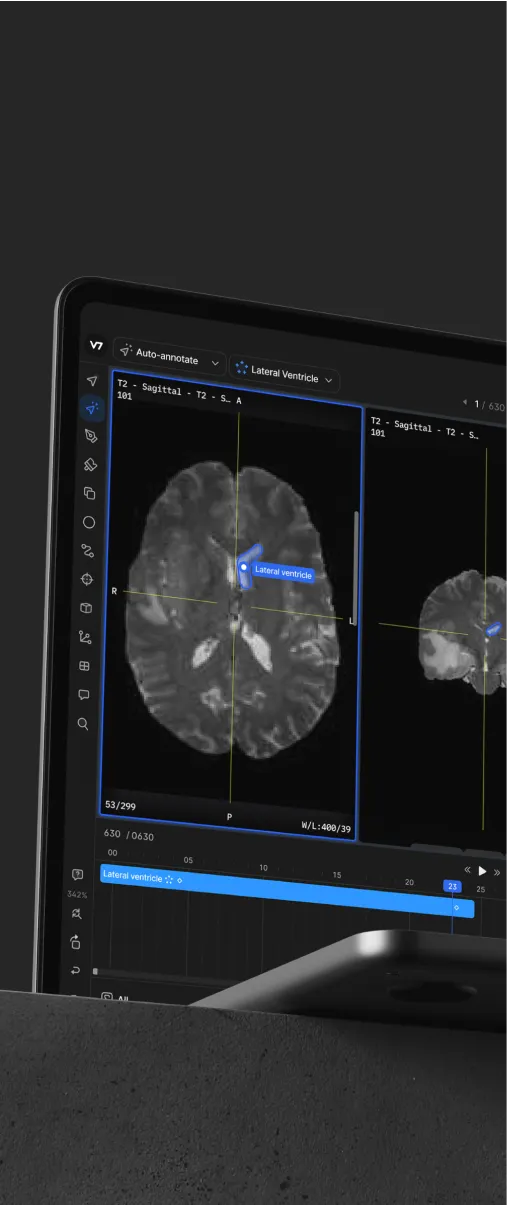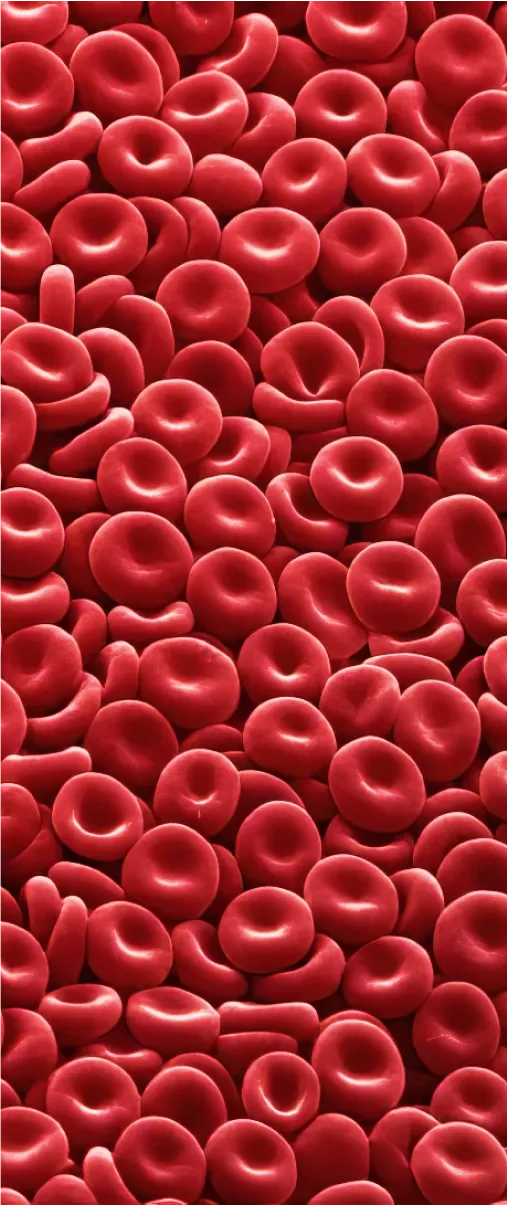Computer vision
27+ Most Popular Computer Vision Applications and Use Cases in 2024
13 min read
—
Jul 25, 2021
Check out the hottest computer vision applications in the most prominent industries including agriculture, healthcare, transportation, manufacturing, and retail.

Alberto Rizzoli
Co-founder & CEO
Computer Vision gives the machines the sense of sight—it allows them to “see” and explore the world thanks to Machine Learning and Deep Learning algorithms.
This powerful technology has quickly found applications across multiple industries, becoming an indispensable part of technological development and digital transformation.
But how exactly do businesses benefit from the use of Computer Vision?
In this article, we’ve put together a list of the most popular computer vision applications across the most prominent industries.
Here’s what we’ll cover:
Transportation
Healthcare
Manufacturing
Agriculture
Retail
And here's the good news—
V7 allows you to annotate your image and video data for any of those use cases (and more!) achieving pixel-level accuracy and speeding up your labeling time by up to 10x.
Ready to streamline AI product deployment right away? Check out:
Now, let's get started.
Transportation
The increasing demands of the transportation sector have propelled technological development in this industry, with computer vision at its center.
From autonomous vehicles to parking occupancy detection, the Intelligent Transportation System (ITS) has become a critical field for promoting the efficiency, effectiveness, and safety of transportation.
Let’s have a look at some of the most popular computer vision applications in this industry.
Self-driving cars
In 2023 autonomous vehicles are no longer science fiction. In fact—
Thousands of engineers and developers worldwide are already testing and improving the reliability and safety of self-driving cars.
Computer vision is used to detect and classify objects (e.g., road signs or traffic lights), create 3D maps or motion estimation, and played a key role in making autonomous vehicles a reality.
Self-driving cars collect data on their surroundings from sensors and cameras, interpret it, and respond accordingly.
Researches working on the ADAS technology combine computer vision techniques such as pattern recognition, feature extraction, object tracking, and 3D vision to develop real-time algorithms that assist driving activity.
Here's how AI traffic light detection works in real life.
Pedestrian detection
Pedestrian detection and tracking have become a vital computer vision research area because of its potential impact on the design of pedestrian protection systems and smart cities.
It uses cameras to automatically identify and locate the pedestrians in images or videos while considering variations related to body attire and position, occlusion, illuminance in different scenarios, and background clutter.
The detection of pedestrians finds applications in fields such as autonomous driving, traffic management, and transit safety and efficiency.
Looking for the perfect bounding box tool? Check out 9 Essential Features for a Bounding Box Annotation Tool before you make a decision.
Parking occupancy detection
Computer vision is already widely used for visual parking lot occupancy detection in Parking Guidance and Information (PGI) systems. It’s an alternative to more costly sensor-based technologies that require regular maintenance.
Thanks to the development of CNNs, camera-based parking occupancy detection systems have quickly achieved extremely high accuracy, almost unsusceptible to changes in illuminance and weather conditions.
Parking occupancy detection can also be combined with License Plate Recognition to keep track of which car is occupying which slot at any given time.
PS. Here are some datasets you can use for training your parking lot detection models:
Traffic flow analysis
Drone and camera-based traffic flow tracking and estimation have also been made possible thanks to the developments in the field of computer vision.
The algorithms can now accurately track and count freeway traffic or monitor and analyze traffic density in urban areas (e.g., at intersections), helping to design better traffic management systems and improve road safety.
Read Best Practices for Annotating with Bounding Boxes to improve your annotations for object detection models.
Road condition monitoring
Computer vision has also been successfully used for defect detection and found application in assessing the infrastructure condition by monitoring changes in concrete and asphalt.
Automated Pavement Distress (PD) detection has proven successful in increasing road maintenance allocation efficiency and decreasing the safety risk related to accidents.
Computer vision algorithms use the collected image data that is later processed to build automatic crack detection and classification systems enabling human-independent targeted rehabilitation and preventive maintenance.
Healthcare
Medical imaging data is one of the richest sources of information. But, here's the caveat—
Without the right technology in place, doctors are forced to spend hours manually analyzing patient data and doing administrative work.
Luckily, as the years went by and the technology advanced, the healthcare industry had become one of the fastest at adopting new automation solutions, including computer vision.
Let’s explore some of the most popular computer vision applications in healthcare.
X-Ray analysis
In the context of medical X-ray imaging, computer vision can be successfully applied to treatment and research, MRI reconstruction, or surgeries planning.
Although most doctors are still relying on the manual analysis of X-ray images for diagnosing and treating diseases, computer vision can automate the process, increasing both efficiency and accuracy.
State-of-the-art image recognition algorithms can pick up patterns in X-ray images too subtle for the human eye.
Have a look at how V7 handles X-Ray image annotation.
CT and MRI
Computer vision is also widely applied in the analysis of CT scans and MRI.
From designing AI systems to analyze radiology images with the same levels of accuracy as human doctors (while reducing the disease detection time) to deep learning algorithms that increase the resolution of MRI images—computer vision is the key to improving patient outcomes.
Here's an example of an ML-assisted brain and spinal cord annotation.
Using computer vision to analyze CT and MRI scans can help doctors to detect tumours, internal bleeding, clogged blood vessels, and other life-threatening conditions. The automation of the process has also proven to increase the accuracy because the machines can now identify details invisible to the human eye.
Check out V7 Medical Image Annotation for more details.
Cancer detection
Image recognition allows doctors to identify anomalies and changes by comparing cancerous and non-cancerous cells in images.
Automated detection allows for a faster cancer diagnosis using data from magnetic resonance imaging (MRI) scans. Computer vision is already successfully applied in breast and skin cancer detection.
Here’s an example of annotated moles that can be analyzed to detect melanoma skin cancer in its early stages.
Blood loss measurement
Postpartum hemorrhaging is one of the biggest causes of mortality in childbirth. Traditionally, physicians could only guess how much blood a patient has lost during childbirth.
Thanks to computer vision, doctors can now measure blood loss during childbirth by using an AI-powered tool to analyze images (taken with an iPad) of surgical sponges and suction canisters.
The Orlando Health Winnie Palmer Hospital for Women and Babies was one of the facilities that implemented this technology. It turned out that in the majority of cases, doctors tend to overestimate the amount of blood lost by patients during child delivery.
Computer vision thus allowed for a more accurate blood loss measurement that helps medical professionals to treat patients more efficiently.
Check out 21+ Best Healthcare Datasets for Computer Vision to find open-source medical datasets for your projects.
Digital pathology
Thanks to the proliferation of whole-slide-imaging (WSI) digital scanners, computer vision can now process medical image data to detect and identify the type of pathology on display.
It is used for:
Image analysis and interpretation
Detailed inspections of sample tissues
Pathology types matching to earlier cases
Diagnosis accuracy and early detection
Computer vision-enhanced digital pathology improved diagnostic accuracy and efficiency, helping doctors save precious time and make better-informed decisions.
Movement analysis
Pose estimation has been used to help analyze patient movement and assist doctors in diagnosing neurological and musculoskeletal diseases.
Although a vast majority of approaches to human pose estimation focus on adults, this computer vision technique has also been applied for Medical Infant Motion Analysis.
By monitoring and assessing an infant’s spontaneous moves, doctors can predict neurodevelopmental disorders at a very young age and take appropriate measures. An automated motion analysis system can capture infant body movements and spot anomalies much more efficiently.
Here are a couple of datasets for training your movement analysis models:
Manufacturing
The manufacturing industry has already adopted a wide range of automation solutions with computer vision at its center.
It helps to automate quality control, minimize safety risks, and increase production efficiency.
Here are some of the most common computer vision applications in the manufacturing industry.
Defect inspection
Large-scale manufacturing sites often struggle to achieve 100% accuracy in defect detection in their manufactured goods.
Camera-based systems can collect real-time data and leverage computer vision and machine learning algorithms to analyze it and benchmark the results against a predefined set of quality standards.
Check out how you can build your own defect detection models using V7.
It helps in identifying macro and micro level defects in the production line more efficiently.
This facilitates the error-free production process and decreases costs.
Reading text and barcodes
As most products have barcodes on their packaging, a computer vision technique called OCR can be successfully applied to automatically detect, verify, convert and translate barcodes into readable text.
By applying OCR to photographed labels or packaging, the text they contain is extracted and verified against databases.
This procedure helps to identify wrongly labeled products, provide information about expiration dates, inform about product quantity in the magazine, and track packages at all stages of product development
Check out this guide to the best AI toots for OCR tasks here.
Product assembly
World-class companies like Tesla have already implemented automation of the product assembly line—the company reported the automation of over 70% of their manufacturing processes.
Computer vision generates 3D modeling designs, guides robots and human workers, identifies and tracks product components, and helps to maintain packaging standards.
Learn more about Artificial Intelligence in Manufacturing.
Construction
The construction sector is quickly embracing the computer vision technology and leveraging it for PPE detection, Infrastructure Asset Inspection, Workplace Hazard Detection or predictive maintenance.
Let's have a closer look at some of the most prominent computer vision us cases in construction.
Predictive maintenance
In the manufacturing environment, it’s common to see material degradation and corrosion causing equipment deformation. If not handled properly, this process can halt the manufacturing lines and compromise ’workers’ safety.
Computer vision helps to monitor the machinery and equipment to find the maintenance needs and address them proactively before it’s too late.

Computer vision-powered devices monitor incoming data from machinery through cameras that identify defects and other changes. When they detect an issue, they send a signal to the system, allowing human operators to take corrective action before an asset is damaged or an accident occurs.
PPE Detection
NIOSH reports that over 2,000 work-related injuries occur daily in the US alone, which could be prevented through the use of PPE.
Deep learning has enabled the detection of protective equipment in various environments, given that the training data is large enough and representative.

Computer vision is therefore successfully used to ensure proper safety measures and security standards. In case of accidents, the AI-assisted systems help quickly identify and assess the intensity of a given occurrence and respond immediately by taking appropriate measures.

Technical advancements in computer vision have also improved the yield estimation processes.
Automatic weeding
Human labor is costly and inefficient when compared to automated solutions. Plus, traditional weeding methods include spraying pesticides, often contaminating neighboring healthy plants, water, or animals.
Computer vision facilitates intelligent detection and removal of weeds using robots (e.g., Ecorobotix or Oz), cutting down costs and ensuring higher yield.
Check out 20+ Open Source Computer Vision Datasets to find suitable datasets for your agriculture projects.
Insect detection
Early insect pest detection helps farmers take appropriate measures to secure their crops and minimize the damage.
Camera-based crop monitoring systems can recognize, classify and count insects threatening the crops.

Automated insect pest control is cost-effective and helps reducing pesticide use.
Livestock health monitoring
Computer vision systems help monitor animals and their actions remotely and in real-time.
It is especially helpful for animal counting, detecting disease or unusual behavior, or monitoring giving birth.

Image or video data can also be combined with other environmental information collected from sensors (such as temperature or ventilation), allowing AI-powered systems to provide farmers with valuable insights on animal’s health or their access to food and water.
Looking for a reliable tool to annotate your data? Compare your options with our list of 13 Best Image Annotation Tools.
Plant disease detection
Computer vision is also widely used for the automated detection of plant diseases, especially crucial at an early stage of plant growth.
Deep learning-based algorithms use image data to identify the diseases, estimate their severity and impact on yield predictions.

Computer vision-based systems far surpass traditional detection methods, which are labor-intensive and costly.
Aerial survey and imaging
Scene and environment monitoring using drones has become an essential element of agricultural transformation.
Farmers can now leverage image data captured by drone cameras and processed using computer vision for remote crop and livestock monitoring and collect information about field geography or soil composition.

Irrigation management
Drones and cameras can capture data that allows for assessing plants’ health and soil composition.
Computer vision systems can process images and obtain the vegetation index (VI) to estimate the soil water balance accurately. This allows farmers for more effective irrigation planning.
Learn more about AI in Agriculture.
Retail
Cameras installed in retail stores allow retailers to collect large volumes of visual data helpful in designing a better customer and employee experience.
The development of computer vision systems to process this data makes the digital transformation of the real industry much more attainable.
This technology has recently been joined by improvements in receipt processing using GenAI.
Here are some of the most popular computer vision applications in the retail industry.
Self-checkout
Autonomous check-out has become possible thanks to computer vision-based systems that understand customers’ interactions and monitor the movement of products.

Cashier-less checkouts are entering the mainstream, tackling many retail store pain points such as long queues.
Would you like to learn more about AI in retail? Check out Autonomous Retail with V7.
Automatic replenishment
Computer vision systems can also capture image data and perform a full inventory scan by tracking items on shelves at intervals of a few milliseconds.
The system can provide instant notifications on stock-outs and sales and help staff with inventory management.

Computer vision technology is also applied to improve store layouts, allow fast A/B testing, produce heat maps, and estimate how long products will stay on shelves.
Intelligent video analytics
By analyzing CCTV camera footage, AI-powered systems can detect suspicious activity and alert staff, who can instantly review it and take appropriate action.

Computer vision-based systems for theft detection have proven to be more accurate as they allow for real-time analysis of the movement. AI-powered cameras can also be used to detect other kinds of behaviors like physical assaults or accidents, thus improving safety.
Foot traffic and people counting
In-store cameras can easily capture the image or video data that computer vision systems use to detect and count people entering and leaving the store.
It is especially useful in times of COVID-19 with enforced social distancing rules and when there is only a limited number of people allowed in a store at once.

Crowd counting is also useful for managing staff changes, queues and it provides useful analytical data for better store management.
Learn more about AI in Retail.
Computer Vision Applications Across Industries: Key Takeaways
As you can see, computer vision can be successfully applied in a wide range of industries that rely on image and video data.
It helps us automate mundane tasks, achieve higher diagnostics accuracy, improve crop yield, and ensure safety.
With more companies adopting the AI-first mindset, we can expect that computer vision will continue being the driving force that transforms industries of all kinds.
💡 Read more:
15+ Top Computer Vision Project Ideas for Beginners
Optical Character Recognition: What is It and How Does it Work [Guide]
What is Data Labeling and How to Do It Efficiently [Tutorial]












